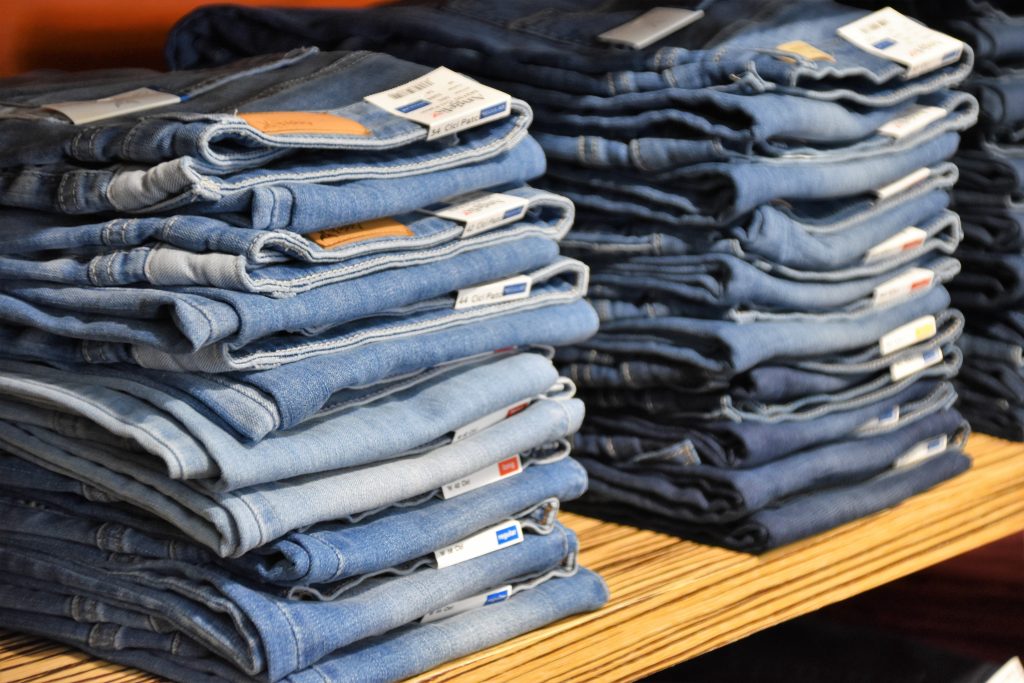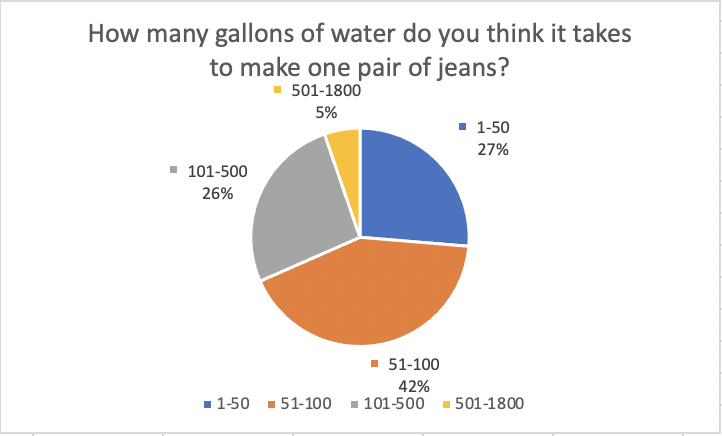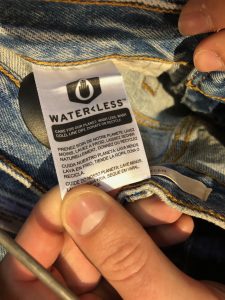Brutally Cheap Fashion
The Power of Denim
Jana Krueger

Fast fashion has become a popular part of American life. Trends come and go so fast, leaving many people rushing to catch up with the latest and greatest fashion trends while leaving fads to sit on hangers in their closets. Because these fashion trends hit the racks one week and are on the clearance rack in the next five, many people are not looking for the most well-made garments and definitely not the most expensive. This constant consumption lifestyle is something that seems like second nature to most people, but it comes at a high cost to the environment. The fashion industry is a leading contributor of water, energy, and waste pollution. One well-known garment and notorious contributor of pollution and waste are jeans.
Jeans are a classic American staple in anyone’s wardrobe. With their white and blue woven structure, jeans have become a versatile garment that can transform any ensemble. What originally began as a way to meet the need of having durable pants for work later manifested into a way to express one’s individual style (Unzipped Staff, 2019). Despite the idea that jean trends do not filter as fast as other fast fashion garments, different styles of jeans capture the eyes of many Americans, leading to a significant amount of annuals sales. Every year, approximately 6 billion pairs of jeans are produced (Webber, 2018). In a $56.2 billion worldwide industry, The United States is the country with the largest denim market of about $13.7 billion (FashionUnited, 2016). It is safe to say that denim is a key garment for many Americans. The average American owns about 7 pairs of jeans, but only wears about 4 of those pairs (FashionUnited, 2016). Initially, this does not sound detrimental. However, after almost 150 years of production, jeans have become an extraordinary contributor to water pollution and waste, unbeknownst to consumers.
Just like many garments, jeans initially start their journey as a cotton seed. Many garments are made from cotton but what people do not know is how environmentally taxing the cotton industry is. Cotton production requires an exceptional amount of water. The global production of cotton uses “over 250 billion tons of water annually” (Environmental Issues with Cotton, n.d.). Not only does cotton require an obscene amount of water, but there are also many chemicals and pesticides used to grow cotton. To ensure that cotton is grown to its fullest with as little interference from weeds and other deterrents as possible, many farmers use chemicals on their crops. This unfortunately has a detrimental effect on the environment. Approximately 25% percent of the world’s insecticides and 18% of pesticides are used to grow cotton” (Mary, 2020). The chemicals can affect air quality and can enter the water sources, having a detrimental effect on ecosystems as well as harm the farmers and the surrounding communities.
Not only is the cotton production for jeans an issue for the environment, the dyeing and distressing of jeans is a major oversight in the contribution to fast fashion pollution. One way that jeans are particularly wasteful is through the dyeing process. Water pollution from the garment’s production process contributes to about 20% of global wastewater (Fleischmann, 2019). Of that 20% of wastewater, 85% of that is contributed by the fabric dyeing process (Fluence News Team, 2020). In order to give jeans their signature blue color, the cotton must be dyed. Once the cotton is dyed, the water is then discarded into the local waterways. Garment dying is the “world’s second-largest polluter of water” because once the water has been used, it is emptied and dumped in waterways that then feed into and pollute major water sources (Maiti, 2020). This can be seen especially in Xintang, China where about 1 in 3 pairs of jeans are produced (Lindwall, 2019). The intense blue water that is used by the community for drinking and bathing is infested with dye chemicals like mercury, lead, and cooper (Lindwall, 2019). This causes not only issues for the environment but also for the health and safety of the community.
“Jeans can be a cheap staple in anyone’s wardrobe but at what cost?”In addition to the dyeing of jeans, another facet of the production is the distressing and finishing of them. Distressing can be done by cutting the fabric, using sandpaper, washing them with stones and chemicals, or by sandblasting. Washing them with stones and chemicals is a very water and chemical-intensive option that poses many risks. It is harmful not only to the environment once the chemicals are disposed of but to the people making the garments. Another option that is frequently used is sandblasting. By using fine sand to create a distressed look on the jean, the inhalation of the sand presents a threat for the laborers in getting silicosis, “a potentially lethal pulmonary disease” (Transparency One). Jeans can be a cheap staple in anyone’s wardrobe but at what cost?
After learning more about the production aspects required to make jeans, I went out to several stores to see the assortment of jeans sold. The first store I visited was TJMaxx. TJMaxx had a moderate assortment of denim from which to choose from. Out of multiple tags attached to jeans, one pair had a label with a recycling symbol that said, “RECYCLED DENIM”. I was initially surprised that one of the main options for denim for women was one that was recycled. However, instead of expecting a tag detailing the sustainability of how the jeans were made, the tag noted that the only thing recycled about the denim was that it was made with 2 recycled water bottles. This is substantially better than the other brand that was offered that had no recycling initiative. Having recycled materials in the jeans is a step in the right direction. At the same time, this does not quite help the original issue that denim is still a highly intensive process that requires a lot of water and manufactures a lot of waste. It takes care of a portion of plastic waste that is still an issue in the world, but it can eventually end up right where it came from: as waste.
I visited Urban Outfitters to see if they offered a different selection. The denim that is sold at Urban Outfitters is at a higher price than what was at TJMaxx. This is to be expected when comparing a specialty retailer to a discount retailer. At Urban Outfitters, they carry their own line of jeans that is produced and manufactured by the company themselves. However, they also carry Levi’s as a national brand option. Comparatively, Levi’s is the most sustainable option out of all the jeans offered. On the main tag that describes the fit of the jean, it says, “Original style. Responsibly made.” From a consumer perspective, this is not that noticeable. Had I not been looking more intently at the garment tags I would have been oblivious to it. As I looked at the inside tags of the jeans, I noticed that they inserted an additional label describing the “Water<less” initiative. It described further to “Care for our planet: wash less, wash cold, line dry, donate or recycle”. Despite this pair of jeans having more tags explaining the care and environmental initiatives, the average consumer would not know how this pair of jeans compares, in terms of sustainability, to the TJMaxx pair. Only if the consumer did research on the production aspects would they know about Levi’s strive to creating more sustainable clothing.
This is a major initiative for the lead producer of denim in the world. This evolution of jean production is committed to using less water to reduce the overall amount of consumption due to production processes. One example of change they have started is by using different methods to finish the fabric. One way of achieving a distressed look can be through stoning that requires a lot of water. By using “a thimble of water and a bit of ozone instead of detergent”, Levi’s is working to use less water (How We Make Jeans with Less Water, 2018). By 2019 to date, “69% of Levi’s bottoms were made Water<Less” (How We Make Jeans with Less Water, 2018). Out of all the jeans offered, these were the ones that were the most sustainably made.
The major distinction, aside from a sustainability perspective, is that Levi’s jeans are substantially more expensive than all the other jeans. The jeans retailed at TJMaxx were ticketed as $16.99 while the pair of Levi’s were retailing for $98.00. This is a massive price difference that contributes to the overall fast fashion debacle. Many consumers are not going to want to pay $80 dollars more for a pair of denim jeans when they can get a pair that they like equally as much for less. The reputability of the brand and sustainability initiative might be able to convince some, but not the majority. Many people might see this as a way to say, “If it’s not broken, do not fix it.” However, there are major cracks in the system. We just do not know it.
“If people really knew the effects of jean production, would buying behaviors change?”
To see if consumers really knew about the consumption of water production needed to produce water, I conducted a survey in which 38 participants recorded their response to how many gallons of water it took to produce a pair of jeans. Only 5% of participants answered correctly with 1800 gallons of water. This survey demonstrated the disparity of information that consumers have when understanding how their clothing, specifically denim, is made. If people really knew the effects of jean production, would buying behaviors change? Would people be willing to change their habits to use less water and pollute less if they knew what their buying habits were contributing to?

The lack of consumer knowledge about garment production is one contributing factor as to why fast fashion has gotten so bad. This deficiency of consumer awareness about how our jeans are made and where they come from leads us to make decisions we may not have made otherwise. Not only that, but it is easy to continue to do what we have been doing when we do not see the effects every day. We do not see the crummy, discolored water streams in our community. We do not have friends and family who have gotten ill from the polluted water or by working in garment factories. Because it is not directly affecting our everyday lives, we can turn a blind eye.
“This deficiency of consumer awareness about how our jeans are made and where they come from leads us to make decisions we may not have made otherwise.”
It is not enough to use ignorance as an excuse anymore. With the amount of access to the information we have today, it possible to get informed on issues that are increasingly detrimental to our future and world. Not only that, but there is a call for companies and retailers to inform their customers. Though Levi’s was putting tags inside their jeans to tell their customers about their own initiative and asking them to continue the work, the visibility of the tag was very small and not advertised on the main outside tag of the jeans. How do you expect consumers to pick the most environmentally friendly jeans and sustainably take care of their jeans if it is not the first thing they see?

Not only does our influence as consumers happen during the checkout process, but it also continues when we go home, wear, and wash our clothes. In addition to my survey, I asked participants how often they washed their jeans. 20.5% of respondents washed their jeans after every use, 56.4% washed their jeans once a week, and 17.9% washed their jeans every two weeks. Additionally, in a Product Life Cycle Assessment conducted by Levi’s, they found that “consumers wear their jeans 2 times before washing them” (Levi Strauss & Co. Reaches 1 Billion Liters of Water Saved Through Sustainability Initiatives; Releases New Environmental Impact Study on Apparel, 2015). Many consumers are not aware that even when the jeans leave the store, they are still contributing to the water waste of the world. In the Product Life Cycle Assessment, they also mentioned that “By wearing jeans 10 times before washing, Americans can reduce their water and climate change impact by 77%”. This is something that every consumer can do to make a better change in the world.
There is so much that as consumers we are not aware of, especially regarding where our clothes come from. The less we know, the less we can demand from companies to provide better products. This disparity in knowledge is vast and can be improved with more transparency and ownership. We ultimately have the power to make the decision as to what we will and will not accept. Fashion trends come and go, but high-quality, sustainable denim never goes out of style.
References
Environmental Issues with Cotton. (n.d.). Retrieved November 30, 2020, from https://www.theworldcounts.com/challenges/consumption/clothing/cotton-farming-water-consumption/story
FashionUnited. (2016, September 26). Infographic – Data from the Denim Industry. Fashion United. https://fashionunited.uk/news/business/infographic-data-from-the-denim-industry/2016092621896
Fleischmann, M. (2019, September 23). How Much Do Our Wardrobes Cost to the Environment? The World Bank. https://www.worldbank.org/en/news/feature/2019/09/23/costo-moda-medio-ambiente
Fluence News Team. (2020, July 06). The Water Footprint of the Blue Jean. Fluence. https://www.fluencecorp.com/blue-jeans-water-footprint/
How We Make Jeans with Less Water. (2018, March). Levi’s. https://www.levi.com/US/en_US/blog/article/how-we-make-jeans-with-less-water/
Interesting Water Facts. (n.d.). Oldham Country Water District. https://www.oldhamcountywater.com/interesting-water-facts.html#:~:text=About%201%2C800%20gallons%20of%20water,about%20150%20gallons%20of%20water.
Lindwall, C. (2019). Are My Denim Jeans Bad for the Environment? https://www.nrdc.org/stories/are-my-denim-jeans-bad-environment
Levi Strauss & Co. Reaches 1 Billion Liters of Water Saved Through Sustainability Initiatives; Releases New Environmental Impact Study on Apparel. (2015, March 17). BusinessWire. https://www.businesswire.com/news/home/20150317005668/en/Levi-Strauss-Co.-Reaches-1-Billion-Liters-of-Water-Saved-Through-Sustainability-Initiatives-Releases-New-Environmental-Impact-Study-on-Apparel
Maiti, R. (2020, August 13). Fast Fashion: Its Detrimental Effect on the Environment. Retrieved November 30, 2020, from https://earth.org/fast-fashions-detrimental-effect-on-the-environment/
Mary, T. (2020, June 21). THE ENVIRONMENTAL IMPACT OF COTTON . Retrieved November 30, 2020, from http://www.gittemary.com/2020/06/the-environmental-impact-of-cotton-%EF%BB%BF.html
Omotoso, M. (2018, June 01). How Denim Manufacturing Impacts the Environment. Fashion Insiders and Co. https://fashioninsiders.co/features/opinion/how-denim-manufacturing-impacts-the-environment/
Ripped Jeans: The “Making Of” — A Look Behind the Scenes. (2017, July 31). Denimology. https://denimology.com/2017/07/ripped-jeans-making-of-look-behind-scenes#:~:text=For%20that%20truly%20fashionable%20feel,pressure%20on%20to%20the%20denim.
Tsai, K. (2017, August 15). How Ethical is the Denim Supply Chain? Transparency One. https://www.transparency-one.com/how-ethical-denim-supply-chain/#:~:text=Weaving%3A%20Denim%20jeans%20begin%20in,and%20horizontal%20threads%20(weft).
Unzipped Staff. (2019, July 04). The History of Denim. Levi Strauss and Co. https://www.levistrauss.com/2019/07/04/the-history-of-denim/
Webber, K. (2018, March 08). The Environmental and Human Cost of Making a Pair of Jeans. EcoWatch. https://www.ecowatch.com/environmental-cost-jeans-2544519658.html#:~:text=%22About%206%20billion%20pairs%20of,in%20a%20more%20sustainable%20way.%22
